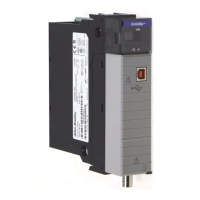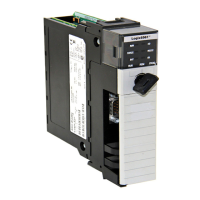Create and configure a coordinate system
24 Rockwell Automation Publication MOTION-UM002F-EN-P - February 2018
Coordinate Definition Defines the number of coordinates in a coordinate system type.
For geometries without orientation support, the coordinate definition defaults to <none>.
For geometries with orientation support, the coordinate definition depends on the geometry Type selection.
Available choices.
• <none>
• J1J2J6
• J1J2J3J6
• J1J2J3J4J5
• XYZRxRyRz
Dimension The number of axes that this coordinated system supports.
This parameter may be read only depending on the controller and the Coordination Definition selection.
Transform Dimension The number of axes in the coordinate system that you want to transform.
This parameter may be read only depending on the controller and the Coordination Definition selection.
Tip: The number of axes to be transformed must be equal to or less than the specified coordinate system
dimension. The transform function always begins at the first axis. For example, if the coordinate system has
three axes but Transform Dimension is set to two axes, then axis one and axis two are transformed. You
cannot specify that only axes two and three be transformed.
Axis Grid
Assigns a motion axis to robot geometry joint for control. The five columns in the Axis Grid provide
information about the axes in relation to the coordinate system.
The number of rows in the grid depends on the robot geometry type and coordinate definition.
Brackets [ ]
Displays the indices in tag arrays used with the current coordinate system. The tag arrays used in multi-axis
coordinated motion instructions map to axes using these indices.
Coordinate Displays the cross-reference to the axes in the grid.
Axis Name Associates an axis tag to the coordinate. The default is <none>.
The list displays the Base Tag axes defined in the project. (Alias Tag axes do not display in the list.)
The tags can be axes associated with the motion group, axes associated with other coordinated systems, or
axes from the Ungrouped Axes folder.
It is possible to assign fewer axes to the coordinate system than the maximum for the Dimension field.
However, a warning displays when verifying the coordinate system, and, if left in that state, the instruction
generates a run-time error.
An axis can be assigned only once in a coordinate system. Ungrouped axes also generate a run-time error.
Opens the Axis Properties dialog box for the axis.
Coordination Mode Displays the axes used in the velocity vector calculations. Possible modes:
• Ancilllary
• Primary
• Orientation
The Coordination Mode depends on the Coordinate Definition selection.
Enable Coordinate System Auto Tag Update
Determines whether or not the Actual Position values of the current coordinated system are automatically
updated during operation. Select the check box to enable this feature.
This feature can ease the programming burden when adding GSV statements to the program. However,
enabling this feature increases the Coarse Update rate which may impact performance.
Whether to use the Coordinate System Auto Tag Update feature depends upon the trade-offs between ease in
programming and increase in execution time.
Tip: Lower the execution time by enabling this feature in initial system programming to formulate the
process and then disable it and enter the GSV statements in the program.
See also
Coordinate System Properties dialog box - General tab on page 22

